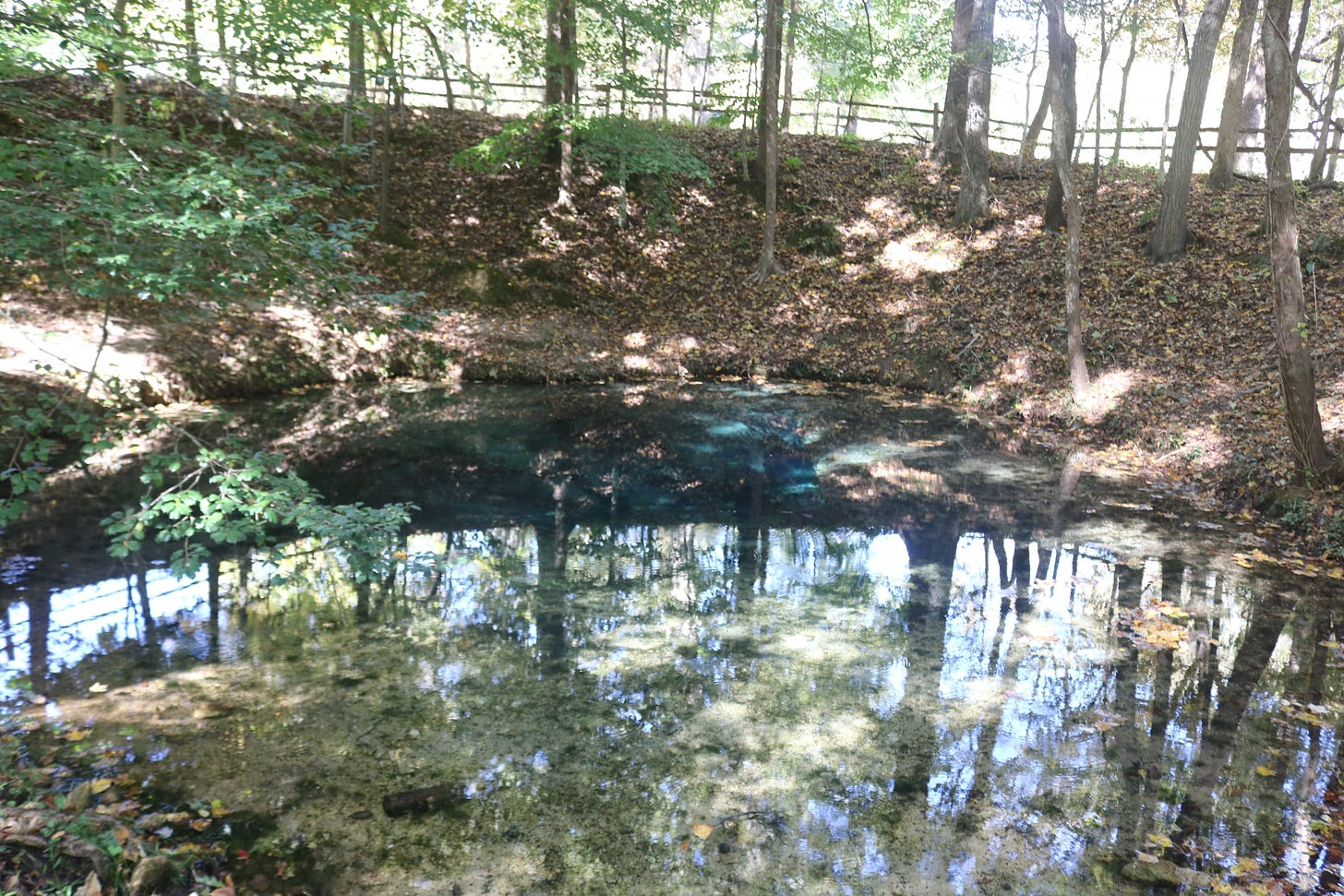The Blue Hole is a spring that provided water during tribal councils at Red Clay.
For my online class, Journey in Place, I was asked to state what I know about the native people in the place where I live. This was my answer.
Journey in Place: Week #4 – Native Chattanooga Who were the Indigenous People in your home ground? What do you know of their culture? Are their descendants still present? When and by whom was your place settled? Where did the settlers come from? A revised version of my answer follows
Archaeologists have identified local artifacts with a 12,000-year history. Much of this evidence is found at Moccasin Bend, a boot-shaped stretch of land enclosed by the Tennessee River on three sides and visible from Point Park on the North end of Lookout Mountain, overlooking Chattanooga and the Tennessee Valley. Artifacts from “The Bend” and nearby Williams Island range from the “Paleo Indian,” Archaic, and Woodland Culture to a Mississippian village site and Civil War fortifications. Mississippian ceremonial mounds once abounded along the river and its tributaries but many were destroyed as the community grew.
The Mississippian culture moved northwest from Mexico. Some historians believe this was a migration, while others think of it as a cultural transformation. The Creek, Seminole, Choctaw, Chickasaw, and other smaller groups speak Muskogean languages. The Yuchi Tribe was among the indigenous people their Mississippian culture encounter
The Yuchi language is a “linguistic isolate” not similar to the Muskogean language of the Creeks or the Iroquoian language of the Cherokees. Some scholars think it was the original language of our region. The Yuchi inhabited parts of Tennessee and Georgia. Although not a Federally Recognized tribe, the Yuchi are recognized by the State of Oklahoma where many of them now reside.
The Yuchi were absorbed into the Creek Confederacy and during the removal, many of them were listed as Creeks on federal registers. William Bartram (1739-1823) spelled their name “Uchi” and reported a village on the “Chatta Uchi” River, perhaps the current day Chattahoochee. It adjoined a Creek village. He states that the residents of the two villages spoke different languages.
The Cherokees are the most visible of contemporary Native cultures, but historians believe they arrived recently, driven out of the Appalachian Mountains by white settlers. Significant historic Cherokee figures include Nancy Ward, a “Beloved Woman” and political leader. Her grave site lies in Polk County, Tennessee. Her mother was the sister of Chief Attakullakulla.
Dragging Canoe, son of Attakullakulla seceded from the Cherokee Nation because he did not agree with the treaties. His band was known as the Chickamauga faction.
John Sevier was the first Governor of Tennessee, possibly because of his success in the wars against the Cherokees immediately following the US War of Independence. Tennessee became the sixteenth state with official documents signed by President George Washington.
Andrew Jackson exploited the historic rivalry between the Cherokees and the Creeks. He recruited Cherokee warriors to assist him in defeating the Creeks at the Battle of Horseshoe Bend in Alabama. He deported the Creek and other Muskogee-speaking tribes to Oklahoma. The Cherokees soon followed, and their journey was commemorated as the Trail of Tears.
Chief John Ross figures prominently in later history. He was only 1/8 Cherokee but exercised leadership to hold the tribe together on the Trail of Tears. His wife died on the trail. Historically, he owned a trading post on the banks of the Tennessee River. It is noteworthy that by the time of John Ross, the chiefdom was an elected office.
The history of the trail is preserved by a unit of the National Park Service and the concept has been expanded to include all removals from the Southeastern United States. Alabama author Jerry Ellis explored his Cherokee heritage by walking its entire length. I highly recommend his book his book Walking the Trail.
Descendants of the Cherokees are abundant here. Red Clay State Historic Park near Cleveland, Tennessee was once the capital of the Cherokee Nation. The Park’s educational programs and festivals celebrate Cherokee Heritage. Casual observers might mistake these events for living history reenactments, but they are part of a living culture.
For a contemporary native perspective of the Cherokee story, read Selu: Seeking the Corn Mother’s Wisdom by Cherokee/Appalachian author Marilou Awiatka. She also appears on a few YouTube videos, including one produced by the University of Tennessee Libraries after she designated their Special Collections department as the recipient of her personal and professional papers.
I have met only one Yuchi and a few Muskogee Creeks, so their presence is less tangible to me. The works of Joy Harjo, the first Native American to be appointed Poet Laureate of the United States, provide a window into contemporary Muskogee Creek culture. Her book, Conflict Resolution for Holy Beings is eye-opening. Some of her traveling performances as a poet and musician are recorded on YouTube.
I am a transplant from Ohio, so I have little knowledge of the European and American settlers here in Chattanooga, Tennessee. I have read that they were predominantly British with up to 20% being Scots.
My knowledge of local history comes from reading the works of Robert Sparks Walker, 1888 – 1960. Walker wrote several historical works, four books of poetry, and two books that would today be classified as YA fiction. I discuss his significance as a conservationist and author in my Substack post, “Robert Sparks Walker, Conservationist.”





I’m so delighted that you have put this information on your page. It is great reference material. Thanks!
Again, this is a treasure of information.